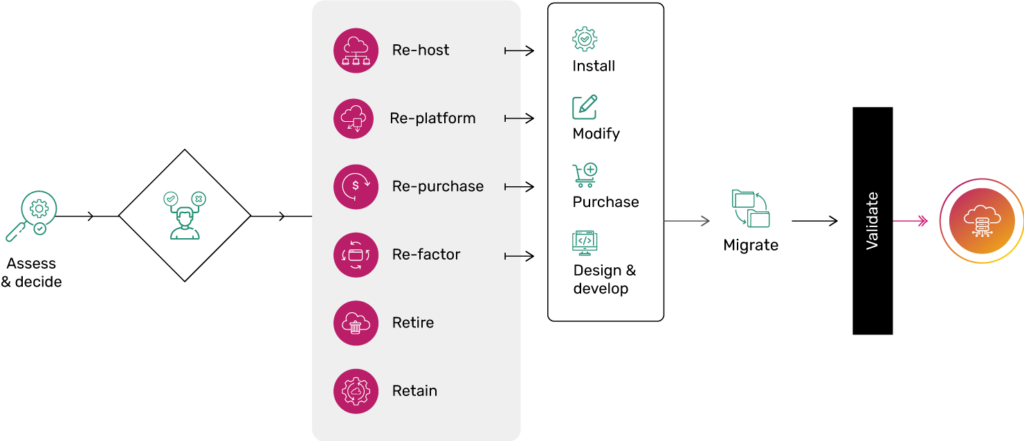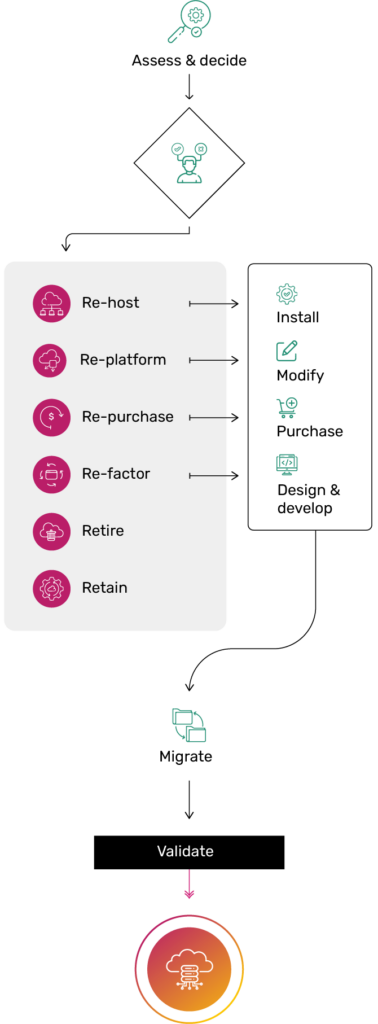
Walking Through the Clouds – Why You Should Fear the Cloud No More
11 years ago, Amazon announced that it was relaunching its cloud storage division into what is now known as Amazon Web Services (AWS).

#FocusOnBestPractices
Migrating to the cloud is no cakewalk. You need a professional cloud management partner to make the transition seamless, and easy. We can handle all your cloud migration challenges with our customized cloud migration services. Migrate your legacy, on-prem applications, data, or infrastructure from any platform to the Azure/AWS cloud. We help enterprises smoothly transition their business towards digital transformation.
The Cloud Migration consists of four phases. These include:
When choosing the Cloud Migration strategy, the following 2 factors are important
The cloud journey is unique for every business. There is no straight formula that fits all migration plans. Every application/ data/infrastructure to be migrated is associated with different cost, compute, security, complexity and performance requirements.
The complexity of migrating these legacy applications varies based on existing architecture, vendor locking, existing licensing, investments made on on-premises, etc.
These are the essential ways to handle the cloud adoption strategy or cloud migration:


Move as -is to cloud
Example: Move On-prem SQL to Azure SQL/ AWS RDS to reduce the amount of time in managing the database instances.
Refactoring or Rearchitecting is reimagining how the application is architected and developed typically using cloud-native features. In this, we mostly rewrite applications from scratch to make their cloud-native applications. (For example, microservices architecture, containers, Kubernetes, etc). These refactored applications are scalable, agile and efficient. When an existing application is not compatible with cloud services, we use refactoring.
On-prem to SaaS with the same capabilities
Repurchase means dropping the existing application and moving to a different product with similar capabilities.
Example: Moving CRM application to Salesforce.com
Keep Them as it is
Retain applications due to heavy investment made/regulatory/security fears/ latency/compliance/ not many benefits of migrating/ application need refactoring before moving to cloud (Upgrade on-prem tools to latest versions to make them compatible for cloud migration).
Get rid of unwanted or no longer useful applications for cost and effort savings.
While migrating to the cloud there might be some crucial old/legacy version applications that may not be compatible with the cloud. For example, DigitalNZ faced compatibility issues. That’s why you need to implement a phased approach for your cloud migration process. This means moving apps that don’t require changes, aligning your virtual network to communicate with your on-premises infrastructure, and re-designing or re-architecting a couple of applications when withdrawing the outdated ones.
Migrating to the cloud will reduce the costs in the mid and long run, but when it comes to the initial migration process, there are implementation costs involved. Migration to the cloud involves costs depending on your project’s scalability and specific business requirements. Each cloud service comes with unique pricing, so you’ll need to think of a pre-migration estimation to avoid pricing or cost challenges.
Applications with heavy customizations and integrations are a challenge due to their complexity. If you have huge applications to migrate to the cloud, choose one at a time.
Databases with larger sizes are a challenge to migrate due to their data size. You can team up with us for help with your cloud migration strategy. Choose small periods to move your huge database to the cloud system. It will help you to complete specific tasks within that time. You need to prioritize according to your business needs.
Inhouse IT teams might have limited skillsets, this will put your business data and security at risk. The perfect way to bridge the technical skill gap is by working with a cloud management partner. Work with a skilled engineering team to ensure zero disruption and high accessibility.
Did you know that Korcomptenz lend a helping hand to a recycling major to enhance its IT application management time by moving from NAV 2016 to Azure cloud? Our client owns a family business related to recycling management and is based out of Pine Brook, New Jersey, USA.
Before approaching us, the client faced some issues such as:
Our client is an education non-profit and helps students with online information related to university study. The client was using the on-premises setup of Microsoft Dynamics CRM 2016 together with a personalized reporting application and SQL Server Reporting Services.
Korcomptenz is a Microsoft Cloud Services Partner and to help you to configure, migrate and support your cloud infrastructure for all your critical business applications.
Contact KORCOMPTENZ for a free consultation to find out about your unique cloud journey to understand the advantages of cloud adoption.

11 years ago, Amazon announced that it was relaunching its cloud storage division into what is now known as Amazon Web Services (AWS).

Microsoft puts the precise number at 162% over three years with complete payback in 7 months in a study by Forrester Research on the Total Economic Impact of Office 365.

One of the most common worries for companies considering a cloud migration strategy is the fear of entrusting your company’s data with a third party.
| Cookie | Duration | Description |
|---|---|---|
| cookielawinfo-checkbox-analytics | 11 months | This cookie is set by GDPR Cookie Consent plugin. The cookie is used to store the user consent for the cookies in the category "Analytics". |
| cookielawinfo-checkbox-functional | 11 months | The cookie is set by GDPR cookie consent to record the user consent for the cookies in the category "Functional". |
| cookielawinfo-checkbox-necessary | 11 months | This cookie is set by GDPR Cookie Consent plugin. The cookies is used to store the user consent for the cookies in the category "Necessary". |
| cookielawinfo-checkbox-others | 11 months | This cookie is set by GDPR Cookie Consent plugin. The cookie is used to store the user consent for the cookies in the category "Other. |
| cookielawinfo-checkbox-performance | 11 months | This cookie is set by GDPR Cookie Consent plugin. The cookie is used to store the user consent for the cookies in the category "Performance". |
| viewed_cookie_policy | 11 months | The cookie is set by the GDPR Cookie Consent plugin and is used to store whether or not user has consented to the use of cookies. It does not store any personal data. |